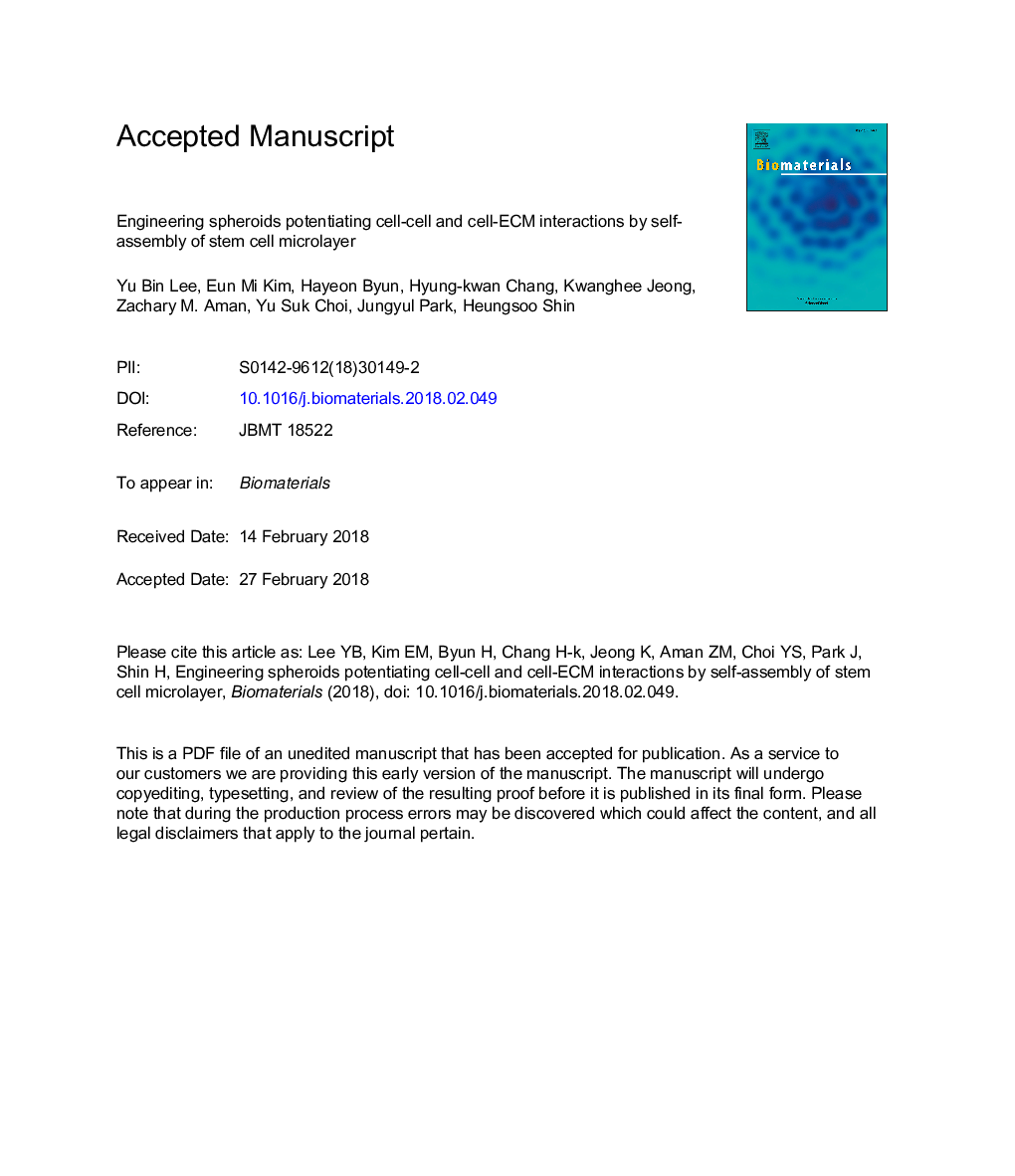| کد مقاله | کد نشریه | سال انتشار | مقاله انگلیسی | نسخه تمام متن |
|---|---|---|---|---|
| 6484573 | 1416102 | 2018 | 51 صفحه PDF | دانلود رایگان |
عنوان انگلیسی مقاله ISI
Engineering spheroids potentiating cell-cell and cell-ECM interactions by self-assembly of stem cell microlayer
دانلود مقاله + سفارش ترجمه
دانلود مقاله ISI انگلیسی
رایگان برای ایرانیان
کلمات کلیدی
موضوعات مرتبط
مهندسی و علوم پایه
مهندسی شیمی
بیو مهندسی (مهندسی زیستی)
پیش نمایش صفحه اول مقاله

چکیده انگلیسی
Numerous methods have been reported for the fabrication of 3D multi-cellular spheroids and their use in stem cell culture. Current methods typically relying on the self-assembly of trypsinized, suspended stem cells, however, show limitations with respect to cell viability, throughput, and accurate recapitulation of the natural microenvironment. In this study, we developed a new system for engineering cell spheroids by self-assembly of micro-scale monolayer of stem cells. We prepared synthetic hydrogels with the surface of chemically formed micropatterns (squares/circles with width/diameter of 200â¯Î¼m) on which mesenchymal stem cells isolated from human nasal turbinate tissue (hTMSCs) were selectively attached and formed a monolayer. The hydrogel is capable of thermally controlled expansion. As the temperature was decreased from 37 to 4â¯Â°C, the cell layer detached rapidly (<10â¯min) and assembled to form spheroids with consistent size (â¼100â¯Î¼m) and high viability (>90%). Spheroidization was significantly delayed and occurred with reduced efficiency on circle patterns compared to square patterns. Multi-physics mapping supported that delamination of the micro-scale monolayer may be affected by stress concentrated at the corners of the square pattern. In contrast, stress was distributed symmetrically along the boundary of the circle pattern. In addition, treatment of the micro-scale monolayer with a ROCK inhibitor significantly retarded spheroidization, highlighting the importance of contraction mediated by actin stress fibers for the stable generation of spheroidal stem cell structures. Spheroids prepared from the assembly of monolayers showed higher expression, both on the mRNA and protein levels, of ECM proteins (fibronectin and laminin) and stemness markers (Oct4, Sox2, and Nanog) compared to spheroids prepared from low-attachment plates, in which trypsinized single cells are assembled. The hTMSC spheroids also presented enhanced expression levels of markers related to tri-lineage (osteogenic, chondrogenic and adipogenic) differentiation. The changes in microcellular environments and functionalities were double-confirmed by using adipose derived mesenchymal stem cells (ADSCs). This spheroid engineering technique may have versatile applications in regenerative medicine for functionally improved 3D culture and therapeutic cell delivery.
ناشر
Database: Elsevier - ScienceDirect (ساینس دایرکت)
Journal: Biomaterials - Volume 165, May 2018, Pages 105-120
Journal: Biomaterials - Volume 165, May 2018, Pages 105-120
نویسندگان
Yu Bin Lee, Eun Mi Kim, Hayeon Byun, Hyung-kwan Chang, Kwanghee Jeong, Zachary M. Aman, Yu Suk Choi, Jungyul Park, Heungsoo Shin,